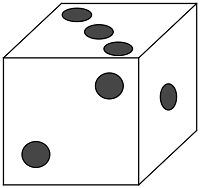SAT Solid Geometry

A white die has gray dots. If the area of each of the die's faces is and the area of each of the die's dots is what is the area of the white surface on the die in terms of and
(A)
(B)
(C)
(D)
(E)
This section requires Javascript.
You are seeing this because something didn't load right. We suggest you, (a) try
refreshing the page, (b) enabling javascript if it is disabled on your browser and,
finally, (c)
loading the
non-javascript version of this page
. We're sorry about the hassle.
Correct Answer: C
Solution:
The area of the white region on the die equals the total surface area of the die minus the area of the gray dots.
A die has 6 sides. Therefore, the total surface area of the die is 6 a . There are 1 + 2 + 3 + 4 + 5 + 6 = 2 1 dots on a die. Therefore, the area that is gray is 2 1 b .
So, A white = A total − A dots = 6 a − 2 1 b .
Incorrect Choices:
(A)
If you think the die has 4 sides, instead of 6, you will get this wrong answer.
(B)
Tip: Read the entire question carefully.
If you only take into account the area of the dots you see in the figure, you will get this wrong answer.
(D)
This answer is a combination of the mistakes in the other wrong choices.
(E)
Tip: Read the entire question carefully.
If you think that a is the length of the die's edge and b is the radius of one dot, you will get this wrong answer.